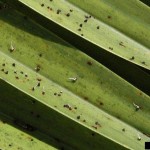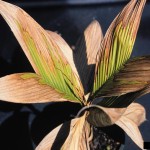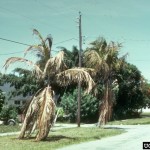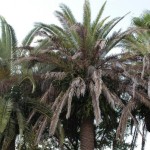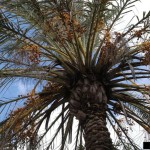Phoenix, Sabal, Washingtonia and others
Graphiola Leaf Spot (syn. False Smut)
|
Fungal pathogen |
Graphiola phoenicis |
|
Area(s) affected |
Leaf blades (usually the oldest leaves) |
|
Signs/Symptoms |
Small, yellow to brown or black, wart-like spots develop on both sides of the leaf surface. As the fungus matures yellow filaments protrude from the middle of the raised spots.
|
|
For more information |
http://itp.lucidcentral.org/id/palms/symptoms/Graphiola_Leaf_Spot.htm |
Cold Injury
|
Causal agent |
Exposure to temperatures below that to which the palms are acclimated to |
|
Area(s) affected |
Entire plant |
|
Signs/Symptoms |
Loss of the outer trunk, browning of the leaves, bud rots and micro-nutrient deficiencies have been attributed to cold injury.
|
|
For more information |
Lethal Yellowing Disease (LYD)
|
Fungal pathogen |
Candidatus Phytoplasma palmae |
|
Area(s) affected |
Leaf blades |
|
Signs/Symptoms |
In the Rio Grande Valley, the Canary Island date palm (Phoenix canariensis) and the true date palm (Phoenix dactylifera) are affected, although other species of palms found in other areas are also susceptible.* The disease is first noticed when lower leaves turn yellow, then brown and droop. The wilt spreads to upper leaves and as the dead leaves collapse they form a “skirt” around the trunk. Eventually, all the leaves drop to the ground and only the trunk remains. Species adapted to Texas that are resistant include: Mexican fan palm (Washingtonia robusta), California fan palm (Washingtonia filifera), pygmy date palm (Phoenix roebelenii), Texas palm (Sabal texana), and Queen palm (Syagrus romanzoffiana). *-Early literature based on observation attributed a large die-off of palm in the Rio Grande Valley to Lethal Yellowing. However, studies on palms exhibiting similar symptoms were identified as Date Palm Lethal Decline (see below). It is largely believed that the original observations may be Date Palm Lethal Decline and NOT Lethal Yellowing (K. Ong)
|
|
For more information |
http://www.apsnet.org/edcenter/intropp/lessons/prokaryotes/Pages/LethalYellowing.aspx |
Leaf spots
|
Fungal pathogens |
Bipolaris sp., Exserohilum sp., Colletotrichum sp., Annellophora sp. |
|
Area(s) affected |
Leaf blades |
|
Signs/Symptoms |
Size and shape of leaf spots vary due to the different fungal pathogens listed above. Spots can appear in a variety of colors: black, brown, yellow, or red and sometimes they appear water-soaked. As the disease progresses a halo will form around the leaf spot. The halo is usually a different color than the leaf spot itself. Leaf spots occur on leaves of all ages, especially juveniles. This disease maybe confused with potassium deficiency. |
|
For more information |
http://itp.lucidcentral.org/id/palms/symptoms/Leaf_Spots_and_Leaf_Blights.htm |
Rachis Blight
|
Fungal pathogen |
Serenomyces californica |
|
Area(s) affected |
Rachis and petiole (the stem that leaf blades are attached to) |
|
Signs/Symptoms |
Brown to reddish-brown streaks (lesions) form longitudinally along the rachis and petiole of the oldest leaves. The disease will eventually migrate to the younger leaves. The lesions disrupt the water-conducting tissue of the leaves and leaflets will die. Discoloration inside the rachis can be observed. Fungal structures may be present within the brown to reddish-brown streaks. |
|
For more information |
Date Palm Lethal Decline (syn. Texas Phoenix Palm Decline)
|
Fungal pathogen |
Phytoplasma |
|
Area(s) affected |
Leaf blades |
|
Signs/Symptoms |
Affected palms will drop all or most of its fruit. Then the oldest leaves will turn red to reddish-brown, beginning at the leaf tip and progressing to the leaf base. On Phoenix palms, the death of the first set of oldest leaves is succeeded shortly afterward by death of the central spear leaf. This is the most indicative symptom associated with this disease. The remaining leaves will continue to die progressively from the older leaves to the younger leaves. Complete death of the tree typically occurs within a few months from the time the first symptoms are observed.
|
|
Hosts |
Canary Island Date Palm (Phoenix canariensis), Date Palm (P. dactylifera), Silver Date Palm (P. sylvestris), Wild Date Palm (P. reclinata), Pigmy Date Palm (P. roebelenii), Cabbage Palm (Sabal palmetto), and Queen Palm (Syagrus romanzoffiana). In Texas, the most frequently affected species is P. canariensis. |
|
For more information |
For additional support and current disease management information, contact your local AgriLife Extension Office: http://counties.agrilife.org/
Content editor: Corinne Rhodes, Undergraduate Extension Assistant, Texas Plant Disease Diagnostic Laboratory. This project was performed to satisfy BESC485 requirement under the supervision of Dr. Kevin Ong, kevo@tamu.edu, Director, Texas Plant Disease Diagnostic Laboratory, Texas A&M University, Texas AgriLife Extension Service (April 25, 2014)
